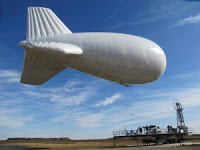 |
| image credit: Raven |
Madison Ruppert, Contributor
Activist Post
The behemoth and corrosive Department of Homeland Security (DHS) seeks to unleash a massive Raven Aerostar aerostat (essentially a blimp) on the U.S. border, which was designed for and used in the war zones of Iraq and Afghanistan.
It’s worth pointing out that if this blimp is used, it would not be the first Unmanned Aerial Vehicle (UAV), or drone, to be flown for surveillance purposes over the U.S. border.
Indeed, the Predator drone is being used quite often to conduct surveillance on the border in a supposed attempt to crack down on illegal immigration, as The Washington Post reported last year.
Furthermore, the use of drones domestically has increased a great deal as of late (which I personally find quite disturbing) and it will only continue to rise with the passage of legislation speeding up the integration of drones into American national airspace.
This project was similar in some ways to other so-called “spy blimp” projects, which have run into many problems, meaning countless additional wasted taxpayer dollars (similar to the “airborne laser” program).
This blimp has long distance surveillance capabilities, somewhat similar to the so-called panopticon drone which is set to be deployed to Afghanistan.
The DHS contends that placing cameras capable of capturing video of miles of the border in a single shot will be the future of border security and surveillance.
The system known as Kestrel is a wide-area surveillance camera system, originally used in the many endless wars in the Middle East.
“You had this imager flying that was able to archive and save imagery and reconstruct [bomb] emplacement so troops could go after [insurgents] later,” said John Applebee, the manager of the DHS border camera program, according to Danger Room.
“It also was used for other things every day, like troop protection or perimeter protection, just as we imagine its uses along the continental borders of the United States,” Applebee added.
During tests, the DHS placed the Kestrel sensor, made by Logos Technologies, on the Raven Aerostar blimp, which is some 75 feet long.
The Raven Aerostar was then tethered above the Arizona desert at 2000 feet, and the DHS claims that the test was a success.
In a statement, the department claimed that Kestrel assisted in spotting “more than 100 illegal attempted entries and alleged illicit activities in progress.”
Applebee seems quite excited about the surveillance platform and what it could do.
“We can see miles from this with a single image frame,” Applebee said. “Within every pixel, you have high-resolution, good, detailed resolution, like high-d-caliber imagery. In every frame, across the frame,”
 To anyone with a remote understanding of technology, this statement probably makes very little sense. A pixel is an individual unit and you can’t have “high-resolution, good, detailed resolution, like high-d-caliber imagery” within a pixel.
To anyone with a remote understanding of technology, this statement probably makes very little sense. A pixel is an individual unit and you can’t have “high-resolution, good, detailed resolution, like high-d-caliber imagery” within a pixel.
A pixel is often defined as the smallest possible unit of a picture which can be represented or controlled, which makes it clearly absurd to say that there could be anything “within every pixel” other than, in some cases, subpixels, although those are completely different than what he seems to be attempting to say.
However, I’ll choose to give him the benefit of the doubt and assume he just expressed himself in an awkward fashion, or something got lost in translation.
The only other conclusion would be that the director of the DHS border camera program has no clue what a pixel is, which is not a good sign and wouldn’t reflect all too well on the competence of the department.
The obvious problem with this kind of technology is that it creates a massive amount of information which analysts then have to process.
Seeing how the military cannot even handle all of the video that they have to analyze, it is laughable to think that the DHS would be able to accurately interpret the video captured from these systems without eating up huge amounts of time and money.
At least Applebee is honest about it in saying, “They [the Pentagon] have the people. We do not.”
The military, of course, also has a much larger budget than the DHS, and even the military has to hire outside contractors to analyze the video, which means that civilians are actually part of the so-called “kill chain,” as exposed last year.
Applebee seems to believe that this massive problem might be solved by software, perhaps somewhat like the so-called behavioral recognition software which was recently awarded a patent.
“We’re looking closely at the developments in the military and intelligence communities for ways the software and analysis can be automated, so can we use software tools as a tripwire to signal us and call agent to attention once [the camera observes] a movement has occurred in a given region,” he said.
The Defense Advanced Research Projects Agency (DARPA) is also working on something which could be applied here with their Mind’s Eye program.
DARPA is developing what they call a “truly ‘smart’ camera [which] would be able to describe with words everything it sees and reason about what it cannot see.”
“In the first 18 months of the program, Mind’s Eye demonstrated fundamentally new capabilities in visual intelligence, including the ability of automated systems to recognize actions they had never seen, describe observed events using simple text messages, and flag anomalous behaviors,” DARPA claims.
If Mind’s Eye is all they claim it is, it would make the behavioral recognition technology currently developed look like child’s play, as this technology would be able “to add the perceptual and cognitive underpinnings for recognizing and reasoning about the verbs in those scenes, enabling a more complete narrative of action in the visual experience.”
No matter what method the DHS ends up employing to process all of the information captured by these systems, be it human or artificial intelligence, it will undoubtedly end up costing the American taxpayer quite a bit.
This is just another instance (like the $1.3 billion in aid to the Egyptian military dictatorship) of the American government acting like we still have money to spend, which we clearly do not.
Did I miss anything or would you like to submit some of your own original writing or perhaps send a story tip or some other information my way? Email me at Admin@EndtheLie.com
RELATED ACTIVIST POST ARTICLE:
Big Government Seeks New Ways to Manage “Big Data”
Please support our work and help us start to pay contributors by doing your shopping through our Amazon link or check out some must-have products at our store.
This article first appeared at End the Lie.
linkwithin_text=’Related Articles:’



Be the first to comment on "DHS imports wartime surveillance technology to U.S. border"